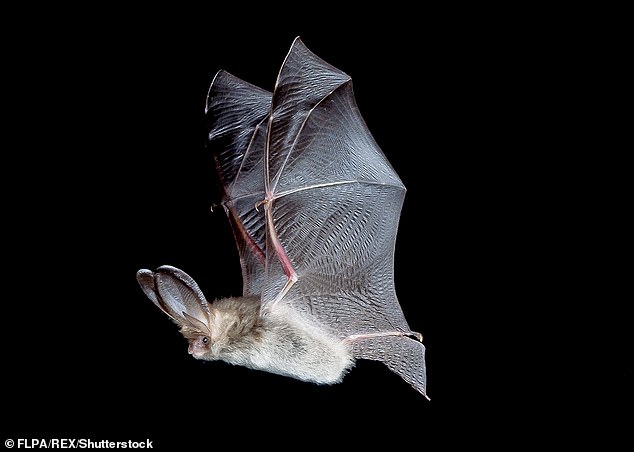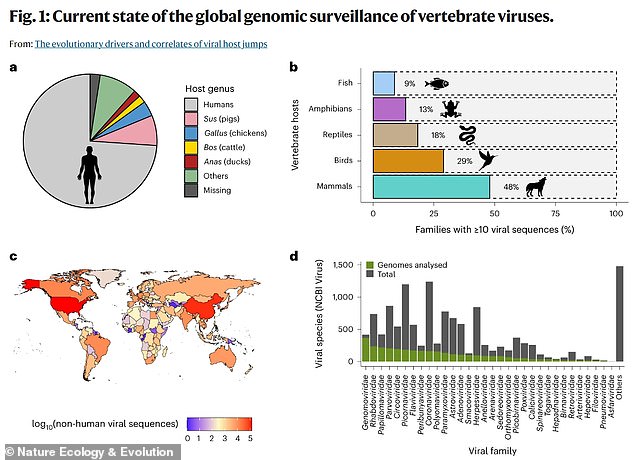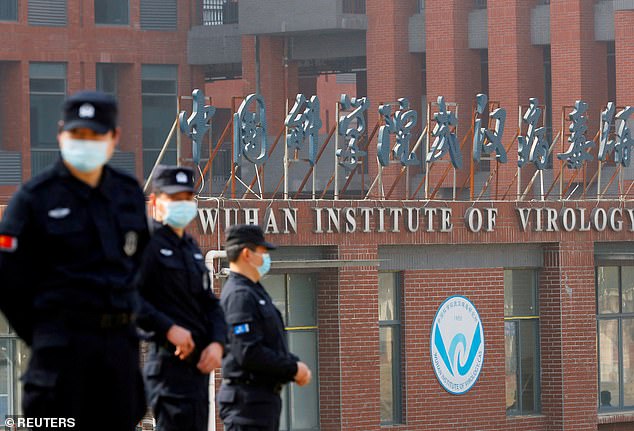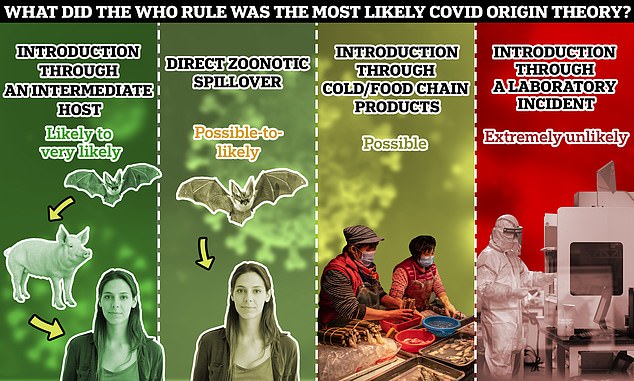For years, scientists have warned that the next pandemic threat could be caused by humans contracting infections from animals.
But now a study suggests the opposite is actually more likely.
Humanity transmits more viruses to animals than we contract from them, researchers at University College London said.
Experts said that “humans are both a source and a sink” of viral health crises.
Professor Francois Balloux, co-author from UCL, said: “We should consider humans as a node in a vast network of hosts that endlessly exchange pathogens, rather than a sink for zoonotic insects.”

Humanity transmits more viruses to animals than we contract from them, researchers at University College London said. Experts said that “humans are both a source and a sink” of viral health crises. Pictured is a brown long-eared bat in Sussex


UCL researchers analyzed tens of thousands of viral genomes in public databases. This allowed experts to look at all the information hidden within a virus, including where the virus jumped species. From this, the team was able to determine whether these pathogens passed from humans to animals (anthroponosis) or the other way around (zoonosis). They found that almost two-thirds (64 percent) of the samples they analyzed were transmitted to animals through humans.
“By studying and monitoring the transmission of viruses between animals and humans, in any direction, we can better understand viral evolution.”
He said this will “hopefully” allow society to “be more prepared for future outbreaks and epidemics of new diseases.”
Concerns have long been growing about zoonotic diseases such as Ebola, which is transmitted from animals to humans, and their potential to trigger pandemics.
However, human-to-animal transmission has received “little attention,” the researchers wrote in the journal. Nature, Ecology and Evolution.
UCL researchers analyzed tens of thousands of viral genomes in public databases.
This allowed experts to look at all the information hidden within a virus, including where the virus jumped species.
From this, the team was able to determine whether these pathogens passed from humans to animals (anthroponosis) or the other way around (zoonosis).
They found that almost two-thirds (64 percent) of the samples they analyzed were transmitted to animals through humans.
Lead author Dr Cedric Tan warned that human-transmitted viruses could “potentially pose a threat to the conservation of the species”.
He added: “It can also cause new problems for humans by affecting food security if large numbers of livestock need to be culled to prevent an epidemic, as has been happening in recent years with the H5N1 strain of bird flu.”
“In addition, if a human-carried virus infects a new animal species, the virus can continue to thrive even if it is eradicated among humans.”
Dr Tan warned it could “even develop new adaptations before it ends up infecting humans again”.
He added: “Understanding how and why viruses evolve to jump to different hosts across the tree of life can help us discover how new viral diseases emerge in humans and animals.”
Some believe Covid jumped to humans from bats in China, potentially through an intermediate species like the raccoon dog or pangolin.


Scientists have largely pointed to the Huanan Seafood Wholesale Market in Wuhan (pictured), where numerous species of live animals were kept and sold, as the potential site where Covid spread naturally from animals to people.


It has been suggested that Covid was created through bioengineering at the Wuhan Institute of Virology (pictured) in central China, which specialized in the study of coronaviruses.


The initial WHO investigation in January 2021, in which a group of scientists traveled to Wuhan, concluded that “all hypotheses remain on the table.” In its March 2021 report, it ranked the likelihood of four theories and considered the natural origins theory to be the most likely. But he placed the lab leak as an “extremely unlikely avenue” behind the frozen food origin story.
Others believe that a laboratory leak is to blame for the pandemic.
China has repeatedly insisted that one of its wet markets, at Covid “ground zero” Wuhan, was the source of the pandemic.
Scientists have largely pointed to the Huanan Seafood Wholesale Market in Wuhan, where numerous species of live animals were kept and sold, as the potential site where the virus spread naturally from animals to people.
Many of the first cases, which occurred in December 2019 and January 2020, had visited the site where live animals were sold.
But Beijing He has also been repeatedly accused of a cover-up, stifling attempts to investigate a laboratory in Wuhan who was experimenting with similar viruses months before the disease emerged in the city.
However, no concrete evidence has been found to support any of the arguments about the origin of Covid, making experts fear that the truth behind the origins of the virus will never be discovered.
